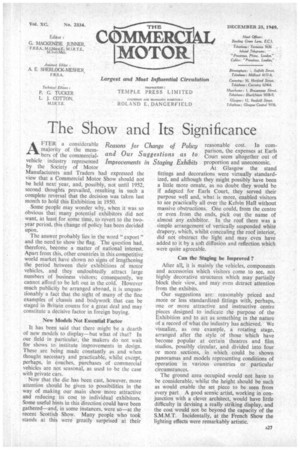The Show and Its Significance
Page 29

If you've noticed an error in this article please click here to report it so we can fix it.
AFTER a considerable majority of the mem bers of the commercialvehicle industry represented by the Society of Motor Manufacturers and Traders had expressed the view that a Commercial Motor Show should not be held next year, and, possibly, not until 1952, second thoughts prevailed, resulting in such a complete reversal that the decision was taken last month to hold this Exhibition in 1950.
Some people may wonder why, when it was so obvious that many potential exhibitors did not want, at least for some time, to-revert to the twoyear period, this change of policy has been decided upon.
The answer probably lies in the word " export " and the need to show the flag. The question had, therefore, become a matter of national interest. Apart from this, other countries in this competitive world market have shown no signs of lengthening the period between their exhibitions of motor vehicles, and they undoubtedly attract large numbers of business visitors; consequently, we cannot afford to be left out in the cold. However much publicity be arranged abroad, it is unquestionably a fact that the sight of many of the fine examples of chassis and bodywork that can be staged in Britain counts for a great deal and may constitute a decisive factor in foreign buying.
New Models Not Essential Factor It has been said that there might be a dearth of new models to display—but what of that? In our field in particular, the makers do not wait for shows to institute improvements in design. These are being made constantly as and when thought necessary and practicable, whilst except, perhaps, in coaches, purchases of commercial vehicles are not seasonal, as used to be the case with private cars.
Now that the die has been cast, however, more attention should be given to possibilities in the way of making our main show more attractive and reducing its cost to individual exhibitors. Some useful hints in this 'direction could have been gathered—and, in some instances, were so—at the recent Scottish Show. Many people who took stands at this were greatly surprised at their reasonable cost. In comparison, the expenses at Earls Court seem altogether out of proportion and uneconomic.
At Glasgow the stand fittings and decorations were virtually standardized, and although they might possibly have been a little more ornate, as no doubt they would be if adapted for Earls Court, they served their purpose well and, what is more, enabled visitors to see practically all over the Kelvin Hall without massive obstructions. One could, from the centre or even from the ends, pick out the name of almost any, exhibitor. In the roof there was a simple arrangement of vertically suspended white drapery, which, whilst concealing the roof interior, did not obstruct the light and may even have added to it by a soft diffusion and reflection which were quite agreeable.
Can the Staging be Improved ?
After all, it is mainly the vehicles, components and accessories which visitors come to see, not highly decorative structures which may partially block their view, and may even detract attention from the exhibits.
Our suggestions are: reasonably priced and more or less standardized fittings with, perhaps, one or more attractive and instructive centre pieces designed to indicate the purpose of the Exhibition and to act as something in the nature of a record of what the industry has achieved. We visualize, as one example, a rotating stage, arranged after the style of those which have become popular at certain theatres and film studios, possibly circular, and divided into four or more sections, in which could be shown panoramas and models representing conditions of operation in various countries or particular circumstances.
The ground area occupied would not have to be considerable; whilst the height should be such as would enable the set piece to be seen from every part. A good scenic artist, working in conjunction with a clever architect, would have little difficulty in devising a really striking display, and the cost would not be beyond the capacity of the S.M.M.T. Incidentally, at the French Show the lighting effects were remarkably artistic.




















































































